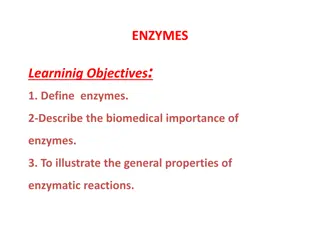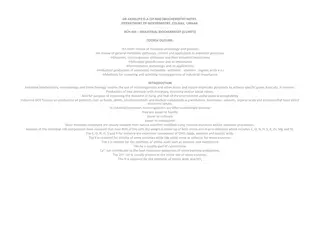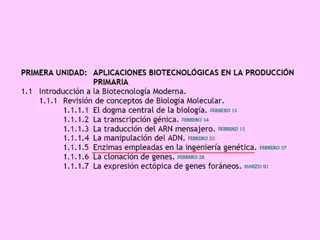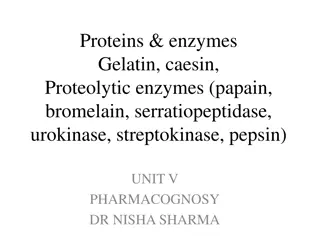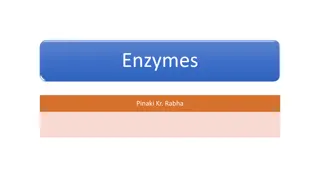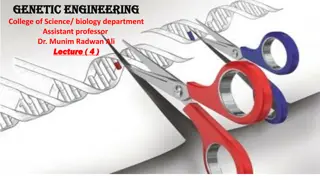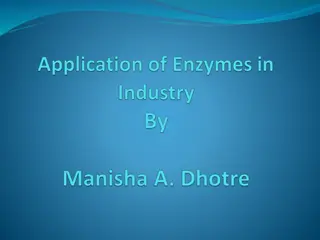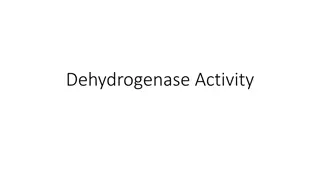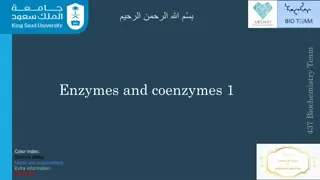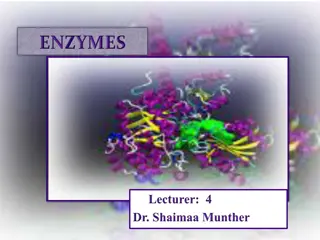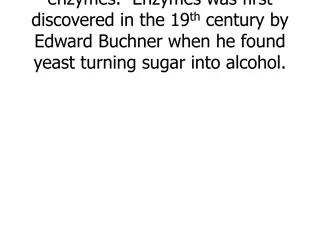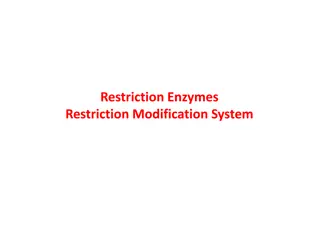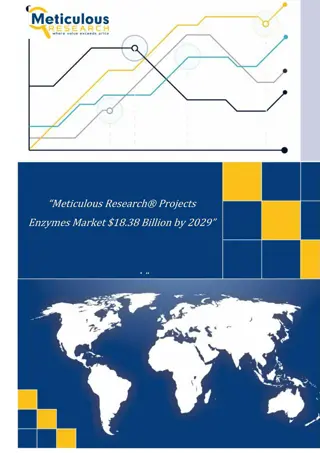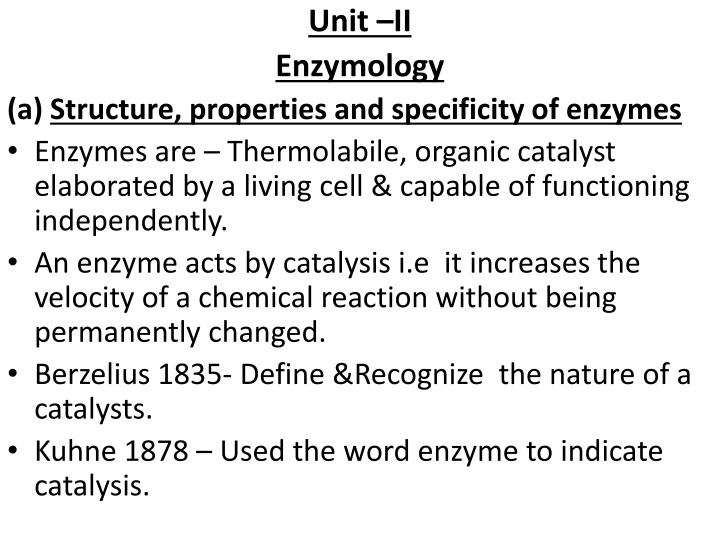
Enzyme Structure, Properties, and Specificity Overview
Learn about the structure, properties, and specificity of enzymes, including their thermolabile nature, catalytic functions, and distinct characteristics. Explore enzyme-substrate complexes, turnover numbers, extracellular vs. intracellular enzymes, and the different types of enzyme specificity.
Download Presentation

Please find below an Image/Link to download the presentation.
The content on the website is provided AS IS for your information and personal use only. It may not be sold, licensed, or shared on other websites without obtaining consent from the author. If you encounter any issues during the download, it is possible that the publisher has removed the file from their server.
You are allowed to download the files provided on this website for personal or commercial use, subject to the condition that they are used lawfully. All files are the property of their respective owners.
The content on the website is provided AS IS for your information and personal use only. It may not be sold, licensed, or shared on other websites without obtaining consent from the author.
E N D
Presentation Transcript
Unit II Enzymology (a) Structure, properties and specificity of enzymes Enzymes are Thermolabile, organic catalyst elaborated by a living cell & capable of functioning independently. An enzyme acts by catalysis i.e it increases the velocity of a chemical reaction without being permanently changed. Berzelius 1835- Define &Recognize the nature of a catalysts. Kuhne 1878 Used the word enzyme to indicate catalysis.
Properties of Enzymes : - Most enzymes are proteins. - They have a globular shape - A complex 3-D structure - Forms colloidal solutions. - Amphoteric in nature. - Large molecular weight. - Nondializable - Remain unaltered at the end of reaction. - Active in a small quantities. - They acts as catalyst- accelerate the rate of reaction
- Monomeric enzyme single polypeptide chain e.g Ribonuclease, Trypsin. - Oligomeric enzyme more than one Polypeptide chain e.g Lactatde hydrogenase. - Multienzyme complex possessing specific sites to catalyze different reactions in a sequence e.g Pyruvate dehydrogenase
Some enzymes are entirely proteins, others contain nonproteinic component (prosthetic group or co- enzyme) along with proteinic component (apoenzyme). Complete enzyme containing both the components is called Holoenzyme. Holoenzyme --------> Apoenzyme + Co-enzyme (Active) (Inactive (Inactive Protein) Non protein) prosthetic groups are tightly bound cofactors Cofactors that are loosely bound and released easily are called coenzymes Many vitamins are coenzymes
Enzyme Substrate Complex : E + S -----> ES -----> E + P Turn Over Number : Catalytic power of an enzyme is measured in terms of TON. --- defined as the no. of substrate molecules converted in to product per unit time when the enzyme is fully saturated with substrate. The value of TON varies with the Enzyme , depends on the conditions in which the reaction takes place.
Extracellular Enzymes : Enzymes produced outside the cell and functioning outside the cell e.g Amylase. Intracellular Enzymes : Enzymes produced within the cell and functioning inside the cell e.g Catalase. Constitutive Enzymes : Those enzymes formed by the cell under any or all the conditions of growth. Induced Enzymes : Enzymes are formed only in response of Inducer.
Specificity of Enzymes : Enzyme display greater degree of specificity with respect to the nature of substrate acted upon. It is a characteristic property of an Active site. Types of Specificity : Absolute Specificity : Enzyme in this group acts only on a single substrate e.g Urease acts only on Urea to produce Ammonia & CO2.
Group Specificity/ Relative specificity : Enzymes capable of catalyzing the reaction of a structurally related group of compounds. This may be dependent on the specific group or a bond present. E.g Proteases acts on peptide bonds of proteins. Glycosidases on glycosidic bonds of carbohydrates and Lipases on ester bond of lipids. Optical or Stereo Specificity : Enzyme will react with only one of the two optical isomers. e.g Arginase acts on L-Arginine and not on D .
Geometrical Specificity : Enzyme exhibit specificity towards the Cis & Trans forms. Broad specificity : Some enzymes act on closely related substrates which is commonly known as broad substrate specificity. e.g. hexokinase acts on glucose, fructose, mannose. Reaction specificity : The same substrate can undergo different types of reactions, each catalysed by a separate enzyme and this is referred to as reaction specificity
(b) ACTIVE SITE : Catalytic site Active of an enzyme is a small region at which substrate binds & contribute the residues to participate in catalysis. Salient features of active site : 1 . Active site occupies relatively small portion of the enzyme molecule 2. Active site is neither a point nor a line or even a plane surface but is a three dimensional native conformation & is due to the tertiary structure of protein.
3. The active site is made up of catalytic amino acids( catalytic residues). 4. The specificity of binding is depends on the precisely defined arrangements of atoms at active site. 5. Active sites are regarded as clefts or crevices. 6. Active site binds the substrates by relatively weak noncovalent bonds. 7. The active site is not rigid in structure and shape. lt is rather flexible to promote the specific substrate binding.
8. The coenzymes or cofactors on which some enzymes depend are present as a part of the catalytic site. 9. The commonly found amino acids at the active sites are serine, aspartate, histidine, cysteine, lysine arginine,glutamate,tyrosine etc.Among these amino acids, serine is most frequently found. 10. The substrate[s] binds the enzyme (E) at the active site to form enzyme-substrate complex(ES). The product( P) is released after the catalysis and the enzyme is available for reuse. E + S -----> ES -----> E + P
Active site of an enzyme can be determined by : Use of Competitive inhibitor. Use of reagents capable of covalently modifying the functional groups at the active site of an enzyme. Affinity labelling technique. X ray diffraction method Use of heavy metals Change in PH
(c) Mechanisms of ES complex formation : E + S -----> ES -----> E + P Many theories have been put forth to explain the mechanism of enzyme-substrate complex formation. Lock and key model or Fischer's template theory : first model proposed by a German biochemist Emil Fischer to explain an enzyme catalysed reaction. According to this model, the structure or conformation of the enzyme is rigid. The substrate fits to the binding site (now active site) just as a key fits into the proper lock.
the active site of an enzyme is a rigid and pre- shaped template, where only a specific substrate can bind. does not give any scope for the flexible nature of enzymes. the model does not give clear idea about the ES complex. Fischer gave two component of active site : responsible for Substrate specificity and catalysis proper.
Induced Fit Model : Induced-fit model of enzyme action was Proposed by Koshland in 1958. In which : - the active site is flexible, not rigid - The interaction of the substrate with the enzyme induces a conformation change in the enzyme, resulting in the formation of a strong substrate binding site.
- the shapes of the enzyme, active site, and substrate adjust to maximize the fit, which improves catalysis. - there is a greater range of substrate specificity - This model is more consistent with a wider range of enzymes describe the situation more accurately.
Substrate strain theory In this model, the substrate is strained due to the induced conformation change in the enzyme. when a substrate binds to the preformed active site, the enzyme induces a strain to the substrate. Fig :
The strained substrate leads to the formation of product. ln fact, a combination of the induced fit model with the substrate strain is considered to be operative in the enzymatic action.
(d) Factors affecting Enzyme activity : The contact between the enzyme and substratei s the most essential pre-requisite for enzyme activity. The important factors that influence the velocity of the enzyme reaction are : 1. Concentration of Enzymes 2. Concentration of Substrates 3. Temperature 4. pH 5.Product Concentration 6. Activators and Inhibitors
1. Concentration of enzyme : As the concentration of the enzyme is increased, the velocity of the reaction proportionately increases. Substrate conc. Should be at saturated amount.
2. Concentration of substrate : Increase in the substrate concentration gradually increases the velocity of enzyme reaction within the limited range of substrate levels. A rectangular hyperbola is obtained when velocity is plotted against the substrate concentration
3. Effect of temperature : Velocity of an enzyme reaction increases with increase in temperature up to a maximum and then declines. A bell-shaped curve is usually observed. Temperature coefficient or Q10 is defined as increase in enzyme velocity when the temperature is increased by 10 C. For a majority of enzymes, Q10 is 2 between 0 C and 40 C. lncrease in temperature results in higher activation energy of the molecules and more molecular (enzyme and substrate) collision and interaction for the reaction to proceed faster.
The optimum temperature for most of the enzymes is between 40 C- 45 C. Few are active even at 100 C, may be due to very stable structure and conformation of these enzymes. Enzymes exposed to a temperature above 50 C, denaturation leading to derangement in the native (tertiary) structure of the protein Majority of the enzymes become inactive at higher temp. (above 70 C)
4. Effect of pH : lncrease in hydrogen ion concentration (pH) considerably influences enzyme activity. a bell-shaped curve is normally obtained. Each enzyme has an optimum pH at which the velocity is maximum. Below and above - the enzyme activity is much lower and at extreme pH, the enzyme becomes totally inactive. Most of the enzymes show optimum activity around neutral pH (6-8). pH influence the enzyme activity by altering the ionic charges on the amino acids (particularly at the active site), substrate, ES complex etc.
5. Effect of product concentration : The accumulation of reaction products generally decreases the enzyme velocity. The products combine with the active site of enzyme and forms a loose complex and thus, inhibit the enzyme activity. this type of inhibition is generally prevented by a quick removal of products formed.
6. Effect of activators : Some of the enzymes require certain inorganic metallic cations like Mg2+, Mn2+,zn2+, ca2+, co2+, cu2+, Na+, K+ etc for their optimum activity. Rarely, anions are needed. Metals function as activators through various mechanisms : combining with the substrate, formation of ES-metal complex, direct participation in the reaction and bringing a conformational change in the enzyme.
Two categories of enzymes distinguished: (1) Metal-activated enzymes : The metal is not tightly held by the enzyme and can be exchanged easily with other ions e.g. ATPase (Mg2+ and Ca2+),Enolase (Mg2+). (2) Metalloenzymes : These enzymes hold the metals rather tightly which are not readily exchanged. e.g.alcohol dehydrogenase, alkaline phosphatase,carboxypeptidase and aldolase contain zinc.Phenol oxidase (copper);Pyruvate oxidase (manganese);Xanthine oxidase (molybdenum);Cytochrome oxidase (iron and copper.)
e) IUB System of ENZYME CLASSIFICATION International Union of Biochemistry (IUB) in 1961 established a Systematic classification and Nomenclature for Enzyme. General Features of IUB system : (I) Enzymes are divided in to Six main classes : 1. Oxidoreductases: Catalyse oxidation reduction reactions 2. Transferases : Catalyse group transfer reactions 3. Hydrolases : Catalyse hydrolytic reactions
4. Lyases removal of group leaving double bonds 5. Isomerases : Catalysing isomerization : Catalyse nonhydrolytic reaction 6. Ligases : Catalyse the synthesis of new bonds Each broad class is divided in to subclasses & sub subclasses. Sub classification describes nature of co- enzyme involved, type of isomerization, type of bond hydrolyzed etc.
(ii) Each enzymes have a systematic code number. e.g. Alcohol dehydrogenase 1:1:1:1 First digit indicate main class 1. - Oxidoreductase Second & Third digit indicate subclass & sub subclass 1:1 acting on CH-OH group 1:1:1 NAD or NADP as acceptor Fourth digit serial number of the enzyme. 1:1:1:1 - Alcohol dehydrogenase (iii) The name of enzyme consist of two parts : First name of substrate & Second ending with - ase type of reaction catalyzed.


